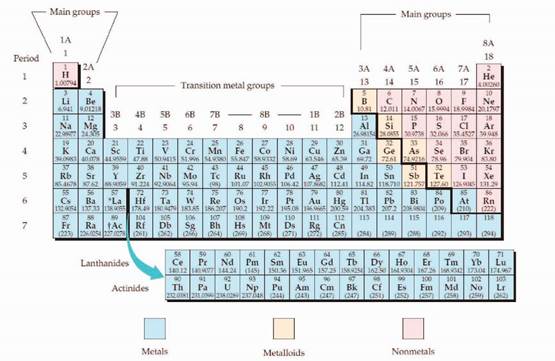
Interpretation:
Valance shell electron and electron dot symbol of the element should be identified when
Concept introduction:
The periodic table is given below,

The electron configuration is the distribution of electrons of an atom or molecule in atomic or molecular orbitals. Atom consists of s, p, d, and f orbitals.
The Aufbau principle:
The Aufbau principle is states that in the ground state of an atom, electrons fill atomic orbitals of the lowest available energy levels before occupying higher levels. For example, the 1s shell is filled before the 2s subshell is occupied.
The subshell ordering by this rule is
Want to see the full answer?
Check out a sample textbook solution
Chapter 2 Solutions
Fundamentals of General, Organic, and Biological Chemistry (8th Edition)
- An oxide of nitrogen contains 63.1% oxygen and has a molar mass of 76.0 g/mol. A. What is the empirical formula for this compound?arrow_forwardDetermine the mass in grams of 2.10 × 10²¹ atoms of copper. (The mass of one mole of copper is 63.55 g.)arrow_forwardWhat is the empirical formula of a compound that contains 72.0% carbon, 12.0% hydrogen and 16.0% oxygen by mass?arrow_forward
- What is the empirical formula for a compound that is 26.56% potassium, 35.41% chromium, and 38.03% oxygen?arrow_forwardA compound with empirical formula C2H5O was found in a separate experiment to have a molar mass of approximately 90 g. What is the molecular formula of the compound?arrow_forwardWhat is the mass in grams of 6.022 * 1023 O atoms of mass 16.00 amu?arrow_forward
- Look up antimony in the periodic table 1Z = 512. How many covalent bonds would you expect it to form? Based on this information, which of the following antimony compounds is covalent and which is ionic: SbCl3 or SbCl5?arrow_forwardWrite the molecular formula for the compound that exhbits a molecular ion at M+ = 84.0574. Assume that C, H, N, and O might be present, and use the exact masses below:arrow_forwardAnother major use of bismuth has been as an ingredient in low-melting metal alloys, such as those used in firesprinkler systems and in typesetting. The element itself is a brittle white crystalline solid. How do these characteristicsfit with the fact that bismuth is in the same periodic group with such nonmetallic elements as nitrogenand phosphorus?arrow_forward
- What is the mass in grams of 30.50 moles of KBr?arrow_forwardFerrous sulfate is one dietary supplement used to treat iron-deficiency anemia. What are the molecular formula and molecular mass of this compound? howmany milligrams of iron are in 250 mg of ferrous sulfate?arrow_forwardThe atomic emission spectrum for a particular element includes blue-violet light with wavelength 440. nm. Calculate the energy in joules of this light given that E = h c/A, and h = 6.63 x 10-34Js, and c = 3.00 x 10°m/s. (h andc are constants, A is wavelength, convert nm into m) h c E =arrow_forward
 Principles Of Radiographic Imaging: An Art And A ...Health & NutritionISBN:9781337711067Author:Richard R. Carlton, Arlene M. Adler, Vesna BalacPublisher:Cengage Learning
Principles Of Radiographic Imaging: An Art And A ...Health & NutritionISBN:9781337711067Author:Richard R. Carlton, Arlene M. Adler, Vesna BalacPublisher:Cengage Learning
